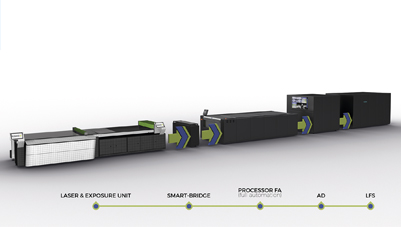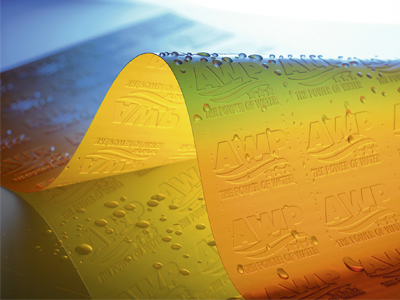Asahi sells plate processing equipment as well as its range of plate materials
The production of a printing plate is the first instance of a job materialising into the physical world. Arguably it is plate advancements which enables flexo to execute technically ambitious results, and so plate imaging has to be perfect. Michal Lodej writes.
When a plate is created it is the first time that all the work completed in the design and pre-press stage is put to the test. An accurate plate production is paramount for a job to be successful and errors can create huge problems further down the production line, often at a great cost.
With the demands on printers today, as well as accuracy, they require efficient production in a compact space. Vianord has developed a multidisciplinary automation system that combines all the popular elements of straightforward automation into one compact and integrated system. The Vianord Engineering Easy to Plate Four, is a fully automated platemaking system; from plate imaging to plate delivery. Within this system is the Smart-Bridge, a compact robotic module that can be tailored to fit any stand-alone imager or combined imager coupled with a proprietary LED exposure. The new concept complements the company’s automated Evo plate imagers, taking even more manual steps out of the process.
Together with its partner Esko, Vianord created a purpose-made Smart-Bridge that connects the high-performance and fully automated platemaking system Evo 5 to the linear CDI Crystal 5080 XPS; where the plate is initially imaged and then is simultaneously exposed through the base and at the back, this configuration is named Evo 5 Fusion E.

Vianord’s Easy to Plate Four Evo5 with Esko’s linear CDI Crystal 5080 XPS
‘At Vianord, we trust in creative and innovative solutions which helps our customers grow and cope with the highly competitive flexo platemaking industry. The use of Esko’s 5080 XPS in combination with our Easy to Plate Evo line allows any customer to respond to their most challenging customers’ issues, increasing turnaround time, improving quality, and producing finest plates. This solution is fuelling the industry’s transformation by automating plate production even more,’ remarked Massimiliano Merlo, global marketing and sales director at Vianord Engineering.
Esko’s vice president hardware, Thomas Klein, explained, ‘Flexo average run lengths are getting shorter, and the industry needs ways to produce those shorter runs faster and more effectively. A considerable part of the solution consists of rethinking flexo platemaking, so far, a complex and highly manual process often involving up to five different hardware devices and six process steps. Integration of process steps and more automation improves quality, consistency and ease of use, and enables customers to more efficiently manage the digital flexo platemaking workflow.’
Esko introduced a range of innovations for flexo platemaking at drupa 2016. These included the CDI Crystal 5080 XPS which integrates and automates flexo plate imaging and exposure and transfers the plate to the processor.
The XPS Crystal 5080 is a UV LED exposure device that combines UV main and back exposure in a single operation. The CDI Crystal 5080 is the new digital flexo plate imager based on the CDI. The devices can be connected with each other to act as one single plate production line, the CDI Crystal 5080 XPS, thus combining plate imaging and exposing into a single operation. This solution cuts the number of manual handling steps by 50% compared to other technologies.
Vertical integration
In an astute business move, many providers of plate material also manufacture plate processing equipment. As well as a range of plate materials, DuPont offers the Cyrel Fast 2000 TD, which the company says provides outstanding quality and productivity in a mid-size (42″ x 60″) format for flexible packaging and tag and label applications.
With an ergonomic and compact design, the Cyrel Fast 2000 TD features new tools and technologies that contribute to higher plate quality, easier workflow and improved machine serviceability. According to the company, plates processed in the 2000 TD processor have better cleanout and relief depth uniformity while providing excellent fine line and dot holding.
The Cyrel Fast solvent-free thermal processing technology produces a press-ready finished plate in one hour or less and improves productivity by eliminating the drying steps. Featuring the one of the smallest environmental footprints for plate making available today, the unit’s thermal workflow can provide up to 53% savings in greenhouse gas generation and up to 63% reduction in non-renewable energy consumption.
Asahi Photoproducts also has a range of plate processing equipment to complement its broad plate portfolio. The AWP 2530 Compact plate processor is Asahi´s smallest solution for manual operation. It consists of two units, processor and filtration, controlled by a central CPU. The processor consists of washer, exposure, dryer, post-exposure and finishing sections within one unit. It is designed for operations producing plates in quantities of approximately 300 sqm/year. It consumes five litres of water per plate with a bath lifetime of up to 30 plates. The AWP 2530 Compact water processor is an environmentally sound solution that drives print forward in balance with the environment.
The AWP 2530 Auto processor is designed for the emerging demands of packaging operations with a plate volume of up to 1500 sqm/year. The combination of processor and plate technology is engineered to deliver a far greater consistency in plate production than conventional.
The AWP 1116 PD inline processor and dryer is designed for operations with a high level of productivity. It uses approximately 12 litres of water per square meter with 6% of a washout detergent. The water is re-used in a cycle, underlining Asahi’s philosophy of driving print forward in balance with the environment.
Something for everyone
There is a wide range of imaging options from the now Flint Group-owned Thermoflexx. The range contains the same plate imaging technology in all of its products but in different sizes to appeal to all types of printers. The product range consists of the Thermoflexx 20, 30, 48, 60 and 80, where the numbers signify the maximum plate size, in inches.
The imagers consist of three independent modules – the motor, the laser and the optics. The flexible design means that replacing any of these modules is straightforward, which simplifies service and hardware upgrades and provides the possibility for remote optical fine-tuning. If there is an error with any section of the head it can easily be dissembled, the broken part replaced, reassembled and then the unit is back up and running again.
The maximum resolution of 5080 dpi is the highest on the market, allowing the production of halftone screens of 250 lpi, which is suitable for intricate and high-quality work, however this will affect the imaging speed.
All the models include the Vacuum Slider Concept (VSC). Plates are held in place on the imager drum with an air suction system that creates a vacuum. The vacuum slider allows printers to produce smaller plates without any loss of suction, keeping them secure during the imaging process.
The two larger models, the 60 and 80, feature the option to use two imaging heads simultaneously which halves imaging time.
Read the full June issue here






